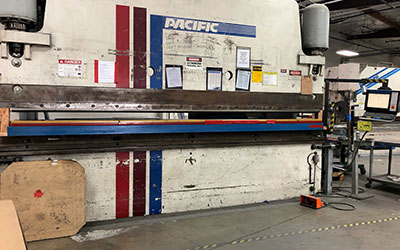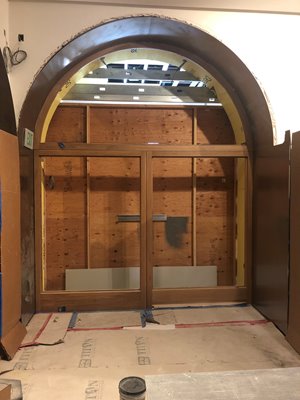 Metal presses are one of the most basic tools of the sheet metal trade. “When we renovated the USS Arizona Memorial in Pearl Harbor, we shaped the gutters, flashings and downspouts with our press brake,” said David Parke, VP of construction operations at Honolulu-based Dorvin D. Leis Company, Inc. “The public has no idea how it was made, but they see the results day in and day out.”
Metal presses are one of the most basic tools of the sheet metal trade. “When we renovated the USS Arizona Memorial in Pearl Harbor, we shaped the gutters, flashings and downspouts with our press brake,” said David Parke, VP of construction operations at Honolulu-based Dorvin D. Leis Company, Inc. “The public has no idea how it was made, but they see the results day in and day out.”
Automation is transforming basic equipment, helping to save time while opening up new architectural possibilities. “I’m a former shop worker, and the technology is light-years beyond what it was when I started,” says Rick Ferguson, chief estimator at Black and McDonald’s in Toronto, Canada. Michelle Lee, co-owner of GES Sheet Metal in Fontana, Calif., agrees, “Presses have really evolved. Now you put a piece of metal in, and the CNC will grab it, bend it, and fold it. The dies are easier to work with and provide more variety for shapes and forms.”
Contractors find that CNC press brakes might be 20 or 30 percent more efficient than a standard brake, speeding jobs up. They even automate tedious work. “CNCs are software driven, so they give you repeatability if you need multiple parts,” says Mike Clark, VP of sheet metal operations at Matherly Mechanical in Midwest City, Okla. “You plug the code in, and the press does the work.”

CSM fabricators operated a 350-ton 3 axis 16-foot Pacific press to form radius panels for portals to the Mingei International Museum in San Diego, California.
California Sheet Metal in San Diego takes full advantage of the changing technology. “We do a lot of new things, so we’re constantly using new techniques and technology,” says CSM shop superintendent Gino Murray. “The challenges the architects give us make the job exciting.”
CSM has won many impressive bids, and that has included all sheet metal aspects of the expansion of the Mingei International Museum in San Diego. The $55 million, two-and-a-half-year renovation is enlarging the two level 1915 Spanish Colonial-style facility from its original 40,000 square feet footprint to a larger 100,000 square feet space, transforming the 43-year-old folk art museum. Lead shop fabricator Dario Montez guides a team of three while field foreman Dustin Vicars and a team of four install 50,000 pounds of stainless steel on site. They started in January 2021 and expect to finish by May.

The gauges of the Cincinnati 175-ton 5-axis press brakes can move independently of each other, whether back and forth or side to side. Operators can lower the back gauges for parts that require a different flange.
The Mingei’s new design requires fabricators to radius 138 sheets of quarter-inch thick stainless-steel. “The panels have a high-end finish that we can’t damage during the forming process,” Murray says. Fortunately, CSM has the right equipment for the job.
“We updated the tooling for our press brake inventory to include radius tooling, whether it be for columns or for making a radius part for a building,” says Buddy Boles, CSM job captain. “We can match the radius the architect gives us with the tooling we buy and make a seamless curve that doesn’t look bumpy or segmented.”
Choosing equipment is a huge responsibility. “We go to shows to see the technology, then do cost analysis,” Murray says. “We did a year plus of research on all the equipment we’re talking about.” Of course, buying quality equipment is not enough.
“We do daily, weekly and monthly maintenance on our press brakes, and a serviceman comes in for a yearly maintenance and functionality check,” says Boles. “If one of those went down, it would impair what we need to do.”

Arched portal installation at the Mingei International Museum in San Diego, Calif. The CSM shop fabricated the quarter-inch thick stainless steel panels in house.
Sometimes there isn’t time for a purchase. “A job jumped up that required a 20-foot press brake, and we didn’t have anything that size,” Murray says. The best option was to modify a 16-foot 250-ton Wysong brake.
“We had to design and fabricate two feet of extension on each side to encompass the 20 feet. We gathered all the press brake operators and all the job captains and figured out how we could do this. We determined how much it was going to cost and got the design approved by an independent person. Now we can do 20-foot jobs at a minimal cost without buying a new brake,” said Murray.
CSM’s success is possible because of their internal culture. “It starts upfront with communication,” notes Murray. “Making a 16-foot into a 20-foot press brake takes about six weeks. If our CEO and vice president don’t let us know what’s coming, there’s no way we’re going to be ready.”
Safety and training are also vital. “These machines can do serious damage if you’re not properly trained, or if you don’t have safety features in place,” Murray warns. “I don’t like to learn from a guy who learned from a guy who learned from another guy. We spend the effort and the money it takes to send our people to get the specific training and expertise we’re looking for.”
The combination of new technology and meticulous preparation allows CSM’s creativity to soar.